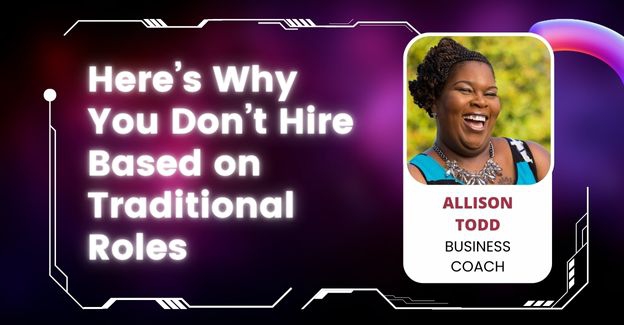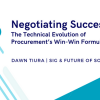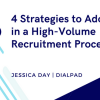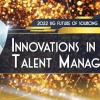The labor market is changing, with candidates interviewing potential companies as much as they’re being interviewed themselves says Allison Todd. To attract talent, Allison shares why employers need to offer a better hiring process that considers the candidate’s creativity and the logic in creating an opportunity for a role they can grow into and thrive.
At the height of the pandemic, over 120,000 businesses temporarily closed, leaving over 30 million U.S. workers unemployed. Job openings have steadily increased since.
In 2021, employers added an unprecedented 3.8 million jobs, but millions of Americans left the labor force. Now, we have more than two million fewer Americans participating in the labor force than in 2020.
It’s clear that able workers are being overlooked or discarded, but the cause isn’t limited to one issue. When the U.S. Chamber surveyed unemployed workers it showed that lack of childcare, ongoing concerns over COVID-19, poor job opportunities and early retirement all contributed to the crisis.
Then, we faced the Great Reshuffle. Following the Great Resignation, the shift in the labor market was focused more on people quitting their jobs in search of better opportunities or more free time – better work-life balance. A total of 4.4 million people quit their jobs in May 2020.
Workers are leaving unfulfilling jobs, and employers need to find solutions to attract and retain new workers. Finding talent is difficult to begin with, but in the midst of a labor shortage, it can be even more challenging.
The answer isn’t just better pay and benefits (it helps!). You need to make sure you take care of your employees, which starts during the hiring process.
Stop Hiring Based on Traditional Roles
Most businesses approach the hiring process the same way. A position needs to be filled, and HR writes a job description with general information like the title, salary, job type, description, company background, job duties and candidate requirements.
That same job listing is posted to job boards and candidates are screened based on algorithms, required fields or general questions that weed out anyone who doesn’t fit the description.
From there, the applicants are screened or interviewed to narrow the pool, sometimes with multiple interviews, and the top contenders are evaluated by key stakeholders.
The questions in the interview may include:
- What are your strengths and weaknesses?
- Why do you want this job?
- Why did you leave/are you leaving your last job?
- What was the biggest challenge you encountered in your last position?
Maybe you get creative and ask the “thought” questions, such as:
- If aliens landed in front of you and offered you any position, what would it be?
- If Hollywood made a movie about your life, who would play your part?
- How would you design a spice rack for a blind person?
- How many balloons would fit in this room?
- Can you tell a joke?
And perhaps the most famous of the creative (weird) interview questions:
You’ve been given an elephant. You can’t give it away or sell it. What would you do with the elephant?
There is a correct answer – open a business and rent the elephant out for events. Obviously.
But really, what are these questions telling you about a candidate and how good of a fit they are for your company’s role and culture?
Okay, the elephant question does demonstrate creativity and business acumen. But based on interviews, you have to choose the right candidate. You have to inform an entire pool of candidates that they didn’t make the cut, and possibly why.
Then, you have to onboard and train your new employee. Depending on the role, this could take weeks or months. And that’s in addition to the weeks and months you’ve already spent with the job listing, screening, and interviews.
That’s a lot of time and money spent to fill one position. Your new employee will take time to learn the ropes as well, so you could be looking at six months, maybe more, from the time the position became vacant to the time you actually see the return on your investment in a new hire.
Can you afford to wait that long? And what if the employee doesn’t work out? What if the employee sees a limit to growth and seeks other opportunities?
Back to the drawing board. New job listing, new screening process, new rounds of interviews.
More elephant questions.
There has to be a better way.
Why Do Employees Leave Jobs?
The self-employment rate in the US increased from 13.5 million in 2019 to 15.2 million in 2020. These workers left the stability of full-time employment and took the risk, not for money, not for flexibility, but for job satisfaction. They have an opportunity to develop skills and tackle new challenges – an opportunity that isn’t offered in their previous position.
Employees aren’t satisfied in a position that doesn’t give them opportunities for growth and development or challenges. Instead of spending their time unhappy, they seek out better opportunities and a role they can grow into, rather than one they’ll outgrow soon.
Unfortunately, this falls squarely on your shoulders. You created this scenario with your hiring process. If you’re hiring based on stringent, traditional roles with cookie-cutter job duties, and a set of unicorn requirements to go along with it, you’re putting your candidates in a box.
They will grow beyond the role, or look for ways to expand their learning and development, and they’ll reach a point where they’re looking for more out of their job.
It doesn’t have to be this way. Instead of always being behind the problem, you can get ahead of it and attract talent by providing the satisfaction they’re looking for.
Find a Better Way to Hire
We’ve gone over the traditional hiring process. Now, let’s look at it from another angle.
The process is largely the same. You have a role you need to fill, you know the general duties and requirements, you know the benefits package and salary range, and you can create a job listing.
Here’s where you flip the script. Instead of outlining a bunch of arbitrary requirements, focus on what you really need for the role.
Naturally, some positions require specific education or training, licensing, or certifications. That’s non-negotiable. But for everything else, consider what is truly needed for the role vs. what would be nice to have.
For example, do you really need someone with 5 or 10+ years of experience? Is a degree really necessary? Is that specific degree necessary? Are these requirements you want so set in stone that you’ll discard candidates based on pre-screening because of them?
The years of experience is a big one, too. If you ask for someone with five years, you’re hiring them for a mid-level position. How much time can you get out of that candidate before they outgrow the position?
If you hired someone just on the verge of the experience level you need, or someone with the important skills you can’t teach, but missing teachable skills like proficiency with certain software, you’d widen your candidate pool significantly.
Once you’ve figured this all out, you can start your interviews. Instead of asking boring, standard interview questions (which they’ve undoubtedly rehearsed), consider radical questions that test their creativity and give you an idea of how they’ll perform in the role.
So, throw away the questions about past positions or strengths and weaknesses. Spare them the silly thought questions about Hollywood and balloons and elephants.
Instead, present them with a problem your company is currently facing. It can be hypothetical, but relevant. Ask them how they would solve it.
For example, tell the candidate that your company is struggling to attract a certain audience segment and ask how they would approach that problem. Ask them what could be improved about the website or the customer’s first impression of the brand.
The answers they provide to these questions can tell you how creatively they think, how well they understand the role they’re applying for, and most importantly, how both the candidate and your company can benefit from a professional relationship.
Get Creative with the Hiring Process
The labor market is changing. It’s no longer a one-way conversation – candidates are interviewing potential companies as much as they’re being interviewed themselves. To attract talent, employers need to offer a better hiring process that considers the candidate’s creativity and offers an opportunity for a role they can grow into and thrive.







